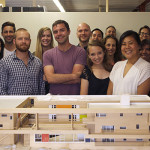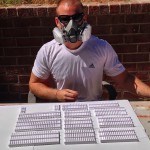August 26, 2014 Summer with Scarpa: Los Angeles and the BarberMcMurry Professor

Scarpa’s Los Angeles-based practice, Brooks + Scarpa, has received more than 50 major design awards, including most recently its reception of the 2014 Smithsonian Cooper-Hewitt National Design Award.
Barnett, one of the fourteen students who participated in the spring studio, was the only Tennessee student selected to intern at Brooks + Scarpa this summer. He is man driven for success, taking on numerous extracurricular activities, including leadership in the university’s chapter of Freedom By Design, the design-build service organization of the American Institute of Architecture Students, and serving as the student representative for the 2014 college campaign.
The College of Architecture and Design caught up with Barnett, learning about his incredible summer at Brooks + Scarpa, presenting at a national conference, and being appointed as chair of the national board of AIAS Freedom By Design.
1. How was your experience at Brooks + Scarpa this summer?
My experience at Brooks + Scarpa has founded, expanded, and built upon some design ideals that will hopefully shape the rest of my career. The extraordinary use of ordinary materials and methods is at the heart of B+S design. This idea of not reinventing the wheel but rather changing the process, purpose, and perception is something that will stick with me forever.
Also their approach of “sustainable” design as simply a standard process of DESIGN in general is very admirable. No projects start with a sustainable concept, but yet every project is designed sustainably because it is the ethical standard for architects of this era to protect the environment.
Lastly, the most amazing part of Brooks + Scarpa is the fact that the firm has no ‘architectural style.’ [T]here are no preconceived ideas of what a project should be or look like. Every project is a blank slate and designed specifically to its concept, context, and client. Every project has an individual soul that is developed through the design process; this soul is what makes every project so successful to me.
2. What types of projects did you work on?

The remainder of my work was spent working on the 18th Street Arts Center, which is a project I was well familiar with from the spring studio. Larry allowed me to work hand-in-hand with him to create the first master plan concept, art gallery, cafe, and live work studios. Myself and one other intern developed this design into presentation drawings, and a preliminary book publication.
3. What was it like participating in Scarpa’s Studio at the University of Tennessee?
Participating in Scarpa’s studio was an amazing experience. All designers at every level are treated as equally talented contributors to design projects. I was pushed to do work that not even I thought was possible from myself. Not only did I have large roles in projects, but I had the opportunity to contribute my own talents and ideas. Everyone in the studio was amazingly talented and more than happy to help when asked. I had the honor of working with everyone from top interns from other schools and countries, to former lead designers of Morphosis…
4. Why do you think it is important that UT has and continues to have opportunities like the BarberMcMurry Studio?
Opportunities like this are crucial to design education as it allows students to work hand-in-hand with the nation’s top design minds. Having professors that are world renowned like Larry Scarpa give a fresh new take on design and can really define students’ educational and professional paths.
I also believe that requiring students to apply for studios like this, and [giving them] the opportunity for future internships creates a sense of healthy competition. It gives students an end goal, something to work towards, something bigger than a final review. This healthy competition forces students to take their work to levels they had not yet reached in hopes of landing a job that will ground them in a prestigious circle of elite designers. This opportunity not only allowed me to go work in Los Angeles but also opened doors in future post graduate education and other high profile design jobs.
5. This summer you also learned that you were named to the national board of AIAS Freedom By Design. Anything that you want to achieve in this role?
I was very excited to learn that I was named the Freedom By Design Advisory Group Chair. It was amazing to start in our own program, at the lowest level possible, and work my way up as not only a leader at UTK, but now the highest appointed position nationally.
My goals at this point are vague, but we will be celebrating the 10 year anniversary of FBD at Forum in Nashville [which the University of Tennessee is hosting]. I have several goals that should bring FBD nationally to an entire new level and vision for the next 10 years. My role as the chair will be to research exploratory ideas that will question, expand, and enhance the current FBD at a national level.
6. You are really involved and driven, why is this?
It is important to be driven because I believe that motivated, goal-oriented, driven people can succeed at anything. I have always been a firm believer that hard work beats raw talent. Due to past life experiences, I learned at an early age to be resilient, and never take anything for granted. If you want something you must go out and take it. I live my life at 150 MPH and never turn down a challenge or opportunity. I have always performed better under pressure than at a relaxed pace, so by challenging myself with many different aspects of the design world, I am also expanding my knowledge.




